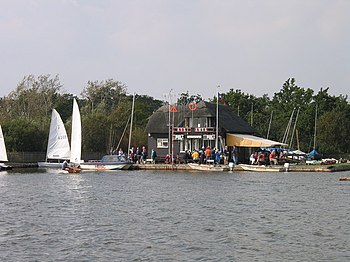Hickling Broad

Hickling Broad is a large, navigable water in Norfolk, amongst the Norfolk Broads 2½ miles southeast of Stalham, and by the village of Hickling.
The broad is not on the course of a main river but is connected by a series of channels and dykes to the River Thurne. Horsey Mere to the east is joined to Hickling Broad by Meadow Dyke, and channels run to the south to Heigham Sound, which is joined by a dyke to the tidal river.
Hickling is the broad with the largest surface area after Breydon Water. Its water is slightly brackish, due to its proximity to the sea.
The navigation channel is only 5 feet deep, under two fathoms, while much of the broad is shallower. Over all, the water is 346 acres, making it one of the largest expanses of open water in East Anglia.
Conservation
Hickling Broad is a National Nature Reserve established by English Nature and in the care of the Norfolk Wildlife Trust, who run boat trips around the reserve for visitors. It is also part of the Upper Thurne Broads and Marshes Site of Special Scientific Interest. In the 1990s, over £650,000 was spent on restoring the reserve, and invasive plants are kept under control by grazing hardy breeds of cattle, sheep and ponies from Eastern Europe. Water levels are managed, and the reed and sedge beds are regularly mown to encourage wildlife.[1]
The broad supports rare waterweeds such as the holly-leaved naiad and three rare species of stonewort. Amongst the rare insects is the Swallowtail Butterfly which feeds on milk-parsley, the Norfolk hawker Aeshna isosceles and emperor dragonfly. Birds that visit the reserve during the winter include cranes, goldeneyes, shovelers and teals, while bitterns, marsh harriers, pochards, water rails and Cetti’s warblers stay for most of the year.[1] There is a waymarked walk around the broad.
Pioneering photographer Emma Turner, lived at Hickling and photographed birds there in the early 20th century.
References
- ↑ 1.0 1.1 Norfolk Wildlife Trust, Hickling Broad NNR, accessed 2010-03-13
52°44′17.39″N 1°34′44.50″E / 52.7381639°N 1.579028°ECoordinates: 52°44′17.39″N 1°34′44.50″E / 52.7381639°N 1.579028°E